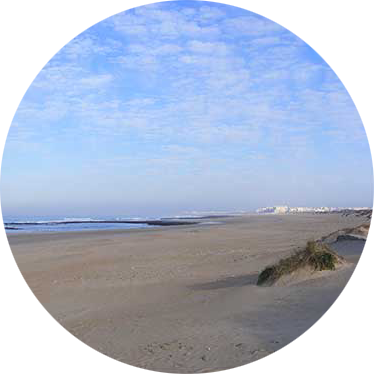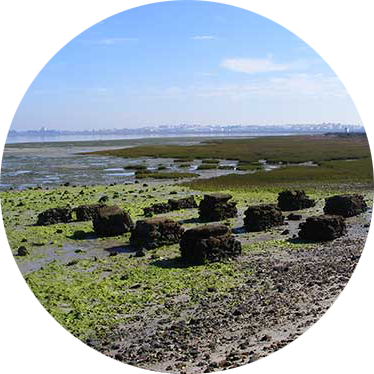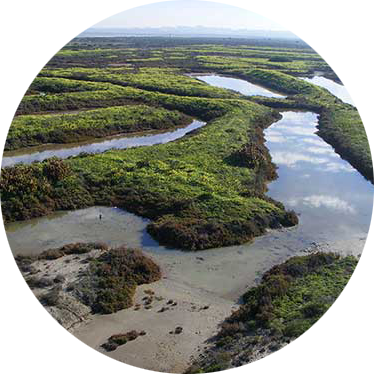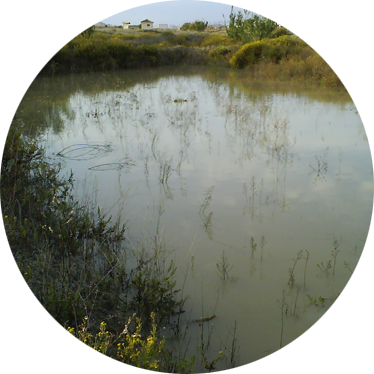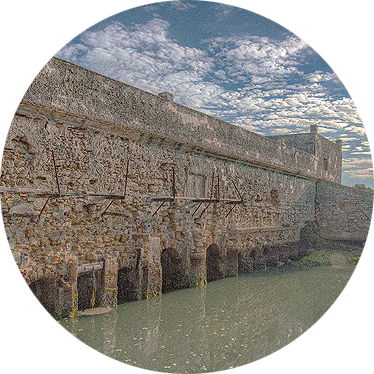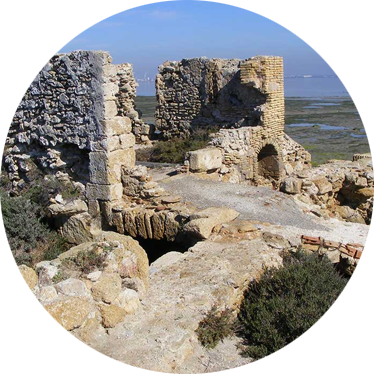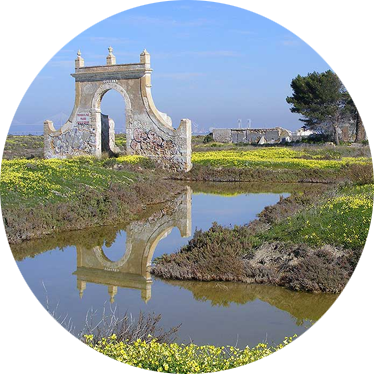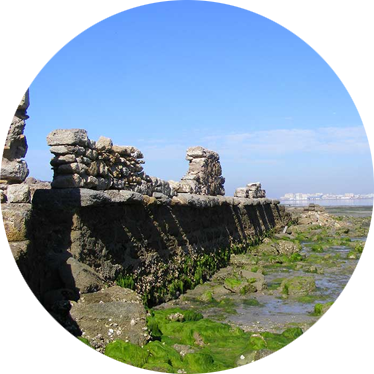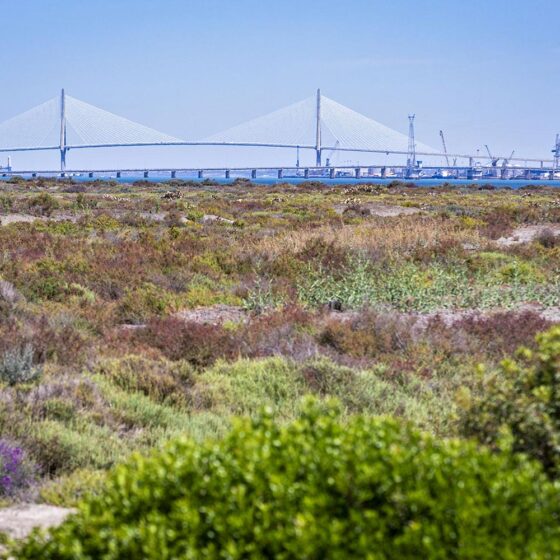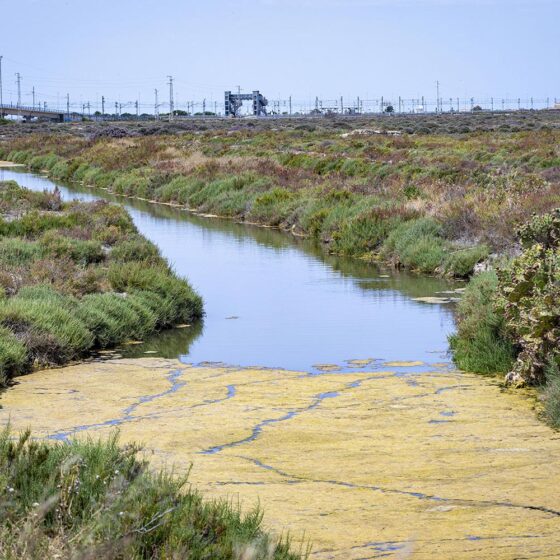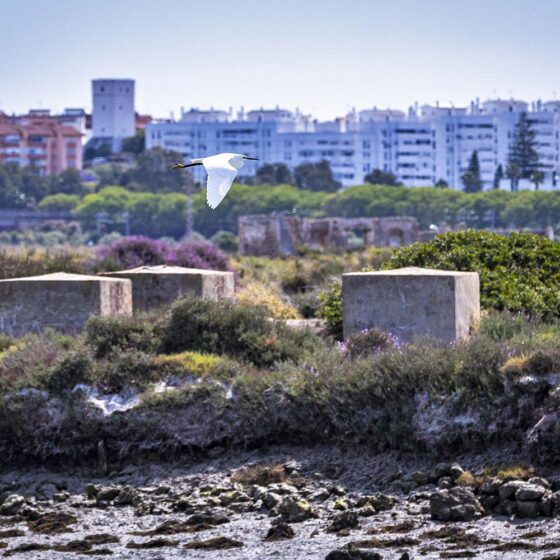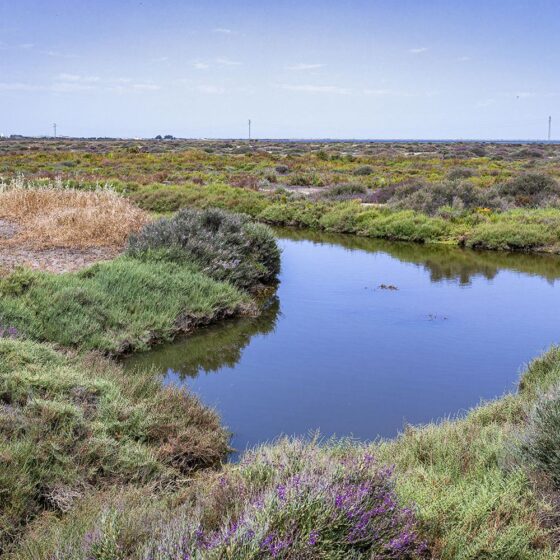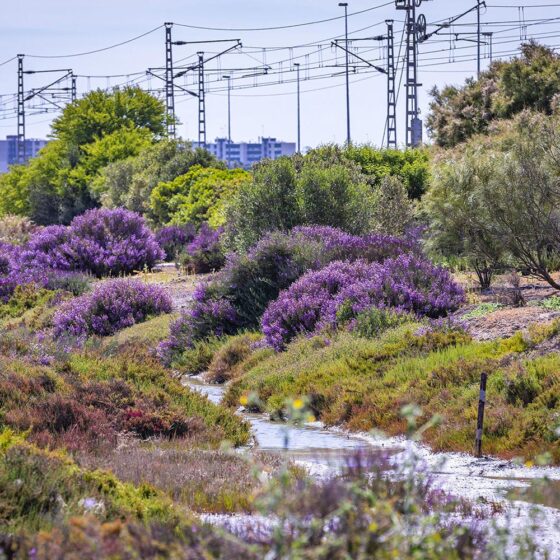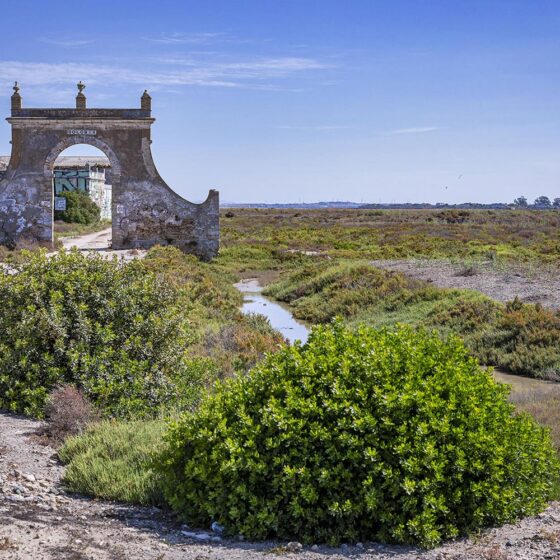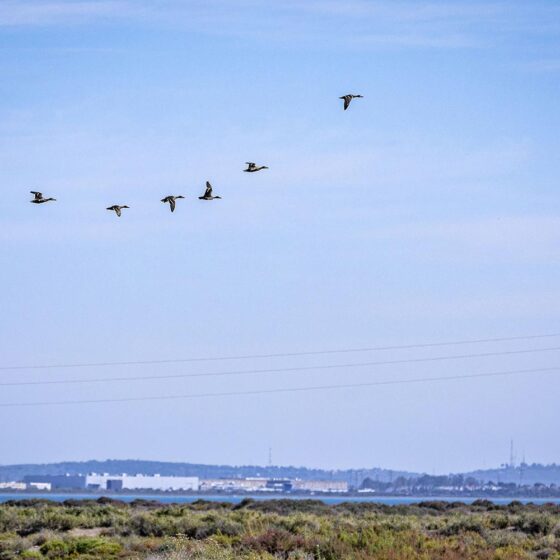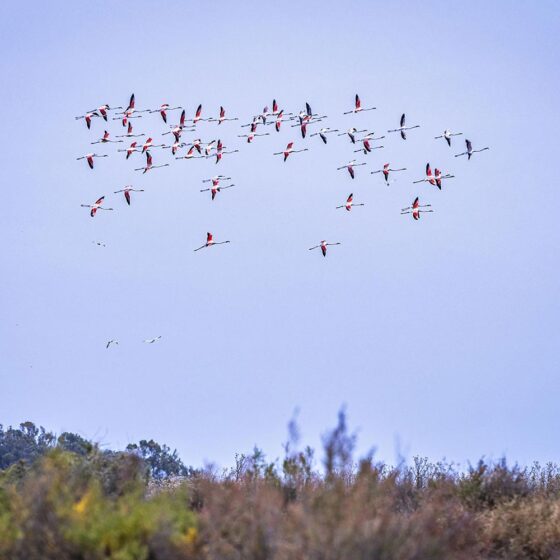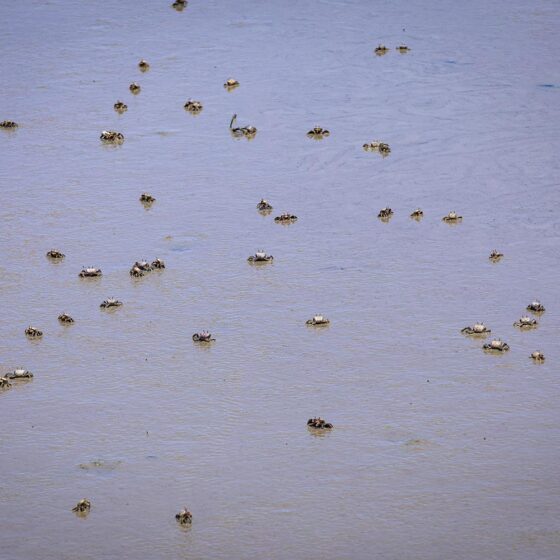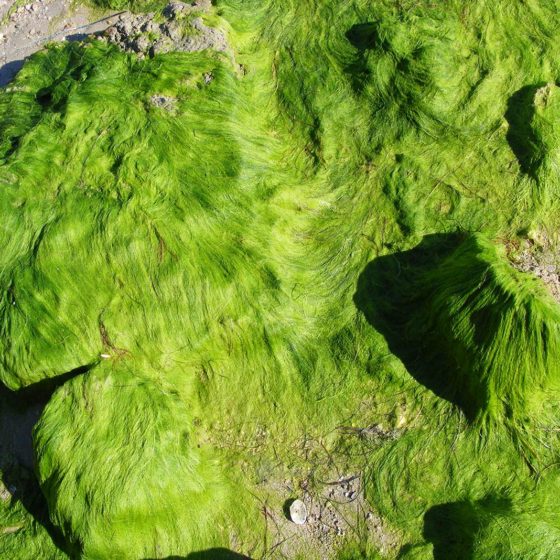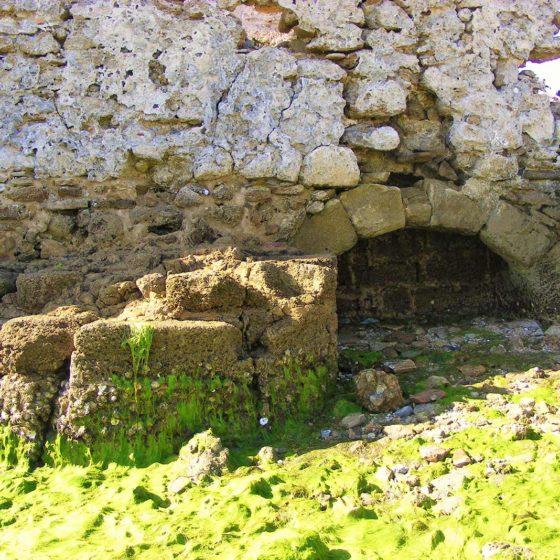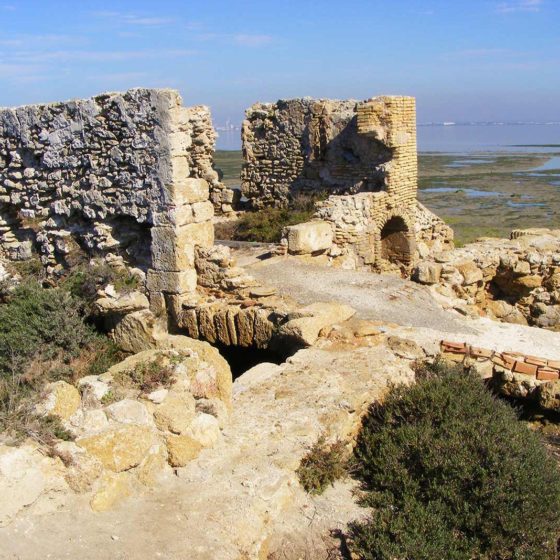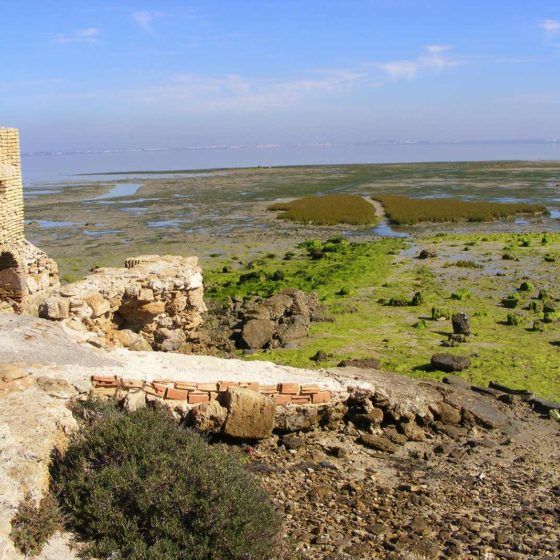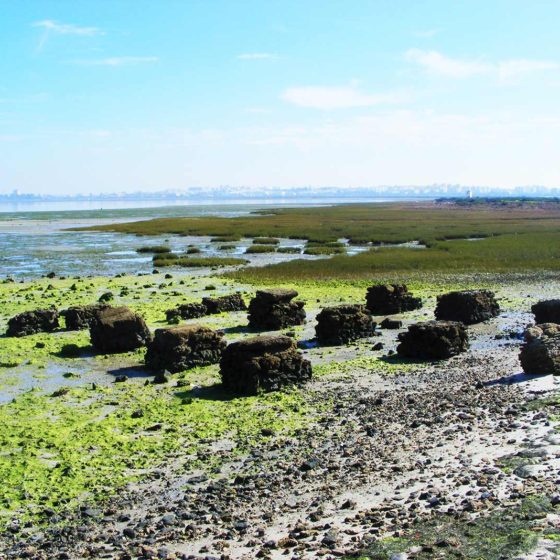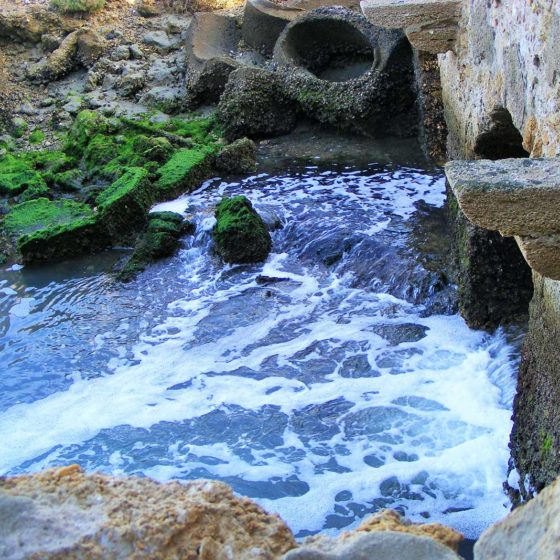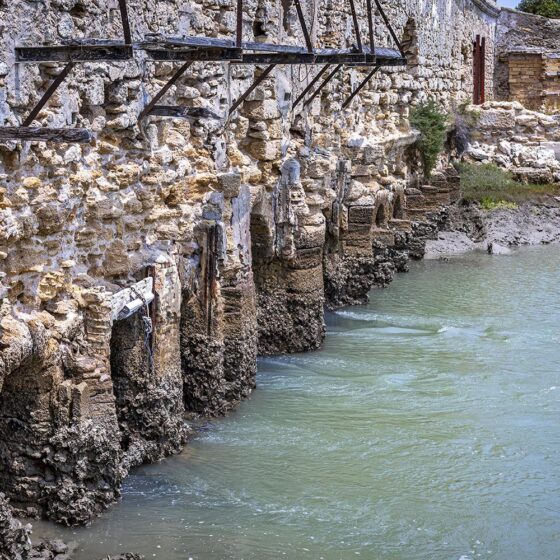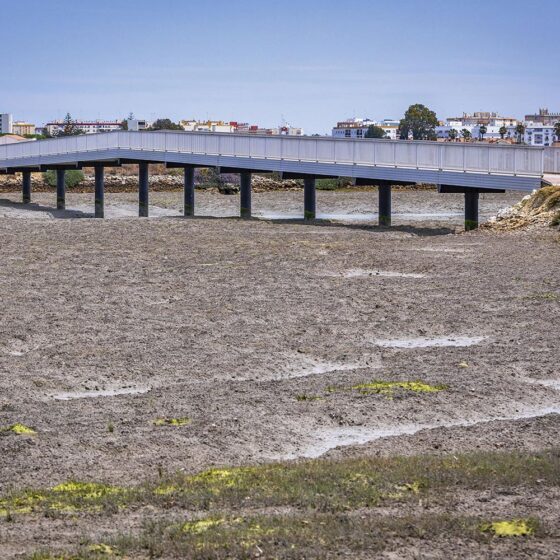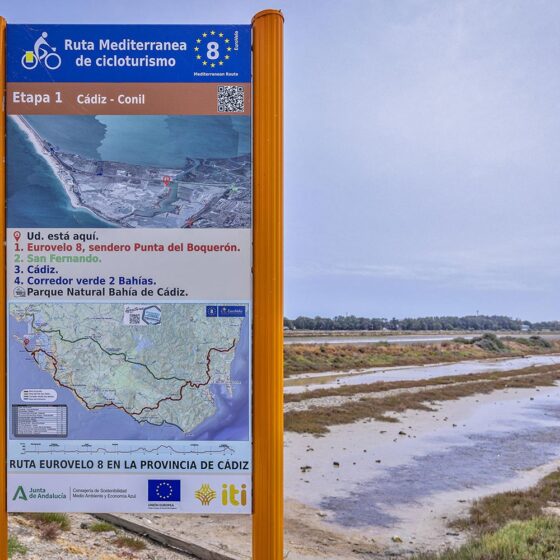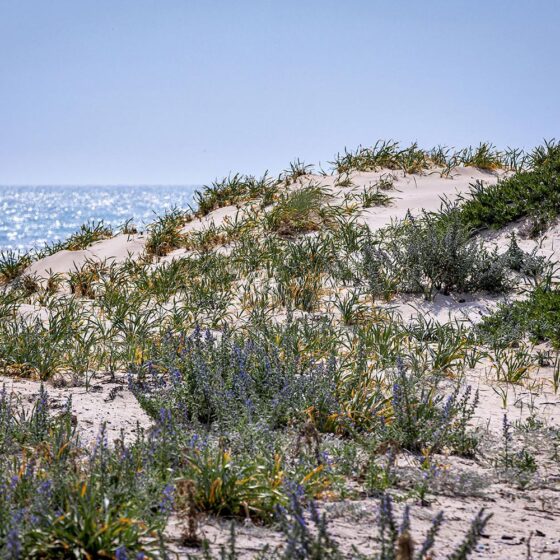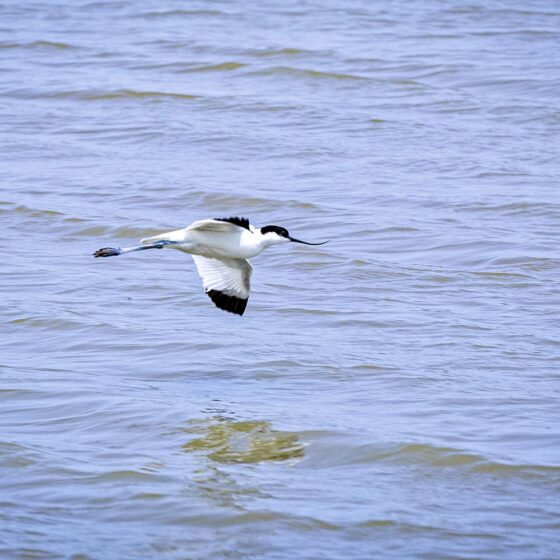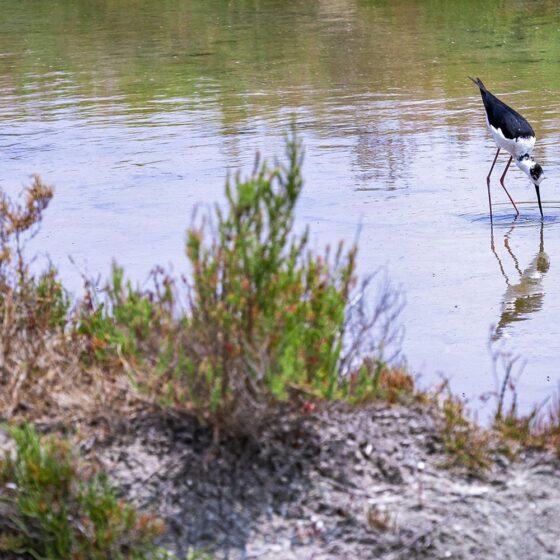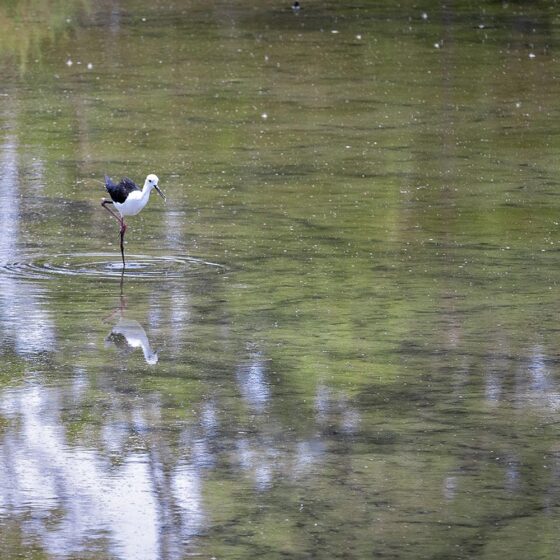The Bay of Cadiz is an area of exceptional natural and cultural value
It is made up of a varied number of interrelated ecosystems, such as beaches, virtually untouched natural marshes, salt flats, intertidal mud flats or coastal pine forests, modified continuously by water and winds.
It is an area where marine and terrestrial environments meet and with a continuous flow of well illuminated water it makes an extremely fragile ecosystem, full of nutrients and ecological richness where a wide diversity of species have established such as molluscs, crustaceans, fish and aquatic birds.
Its location between the neighbouring Doñana National Park and the Strait of Gibraltar makes the Bay of Cadiz a key part of the migratory system of many aquatic birds. In addition, it makes it one of the most important coastal wetlands in Europe for nesting, rest and feeding of more than 150 species of waterfowl.
After the Doñana National Park, the Nature Park of the Bay of Cadiz is the area of greatest expanse and ornithological importance of Andalusia, usually harbouring populations of more than 50,000 aquatic birds, of which 50% are waders (sandpipers, plovers, stilts, bar-tailed godwit), 30% belong to anatidae (silbones, blackbirds, common merganser, common shelduck), 15% to several species of gulls and terns and the remaining 5% to other species, such as flamingo, grey heron, egret, cormorant, osprey, kestrel, etc.
It is estimated to have about 3,000 breeding pairs among the 12 species of nesting aquatic birds in spring (the Park is home to one of the most important breeding colonies of European baby terns), although the bulk of the avifauna is formed by migratory birds that use these enclaves to winter or just to take a break on their migratory routes with Africa.
In addition, the Bay of Cadiz is also a fundamental place for breeding and spawning of numerous species of fish and invertebrates, some of them listed as endangered on the red lists of the IUCN (International Union for the Conservation of Nature).
Map of the Bay of Cadiz Nature Park and surroundings in the municipality of Cadiz
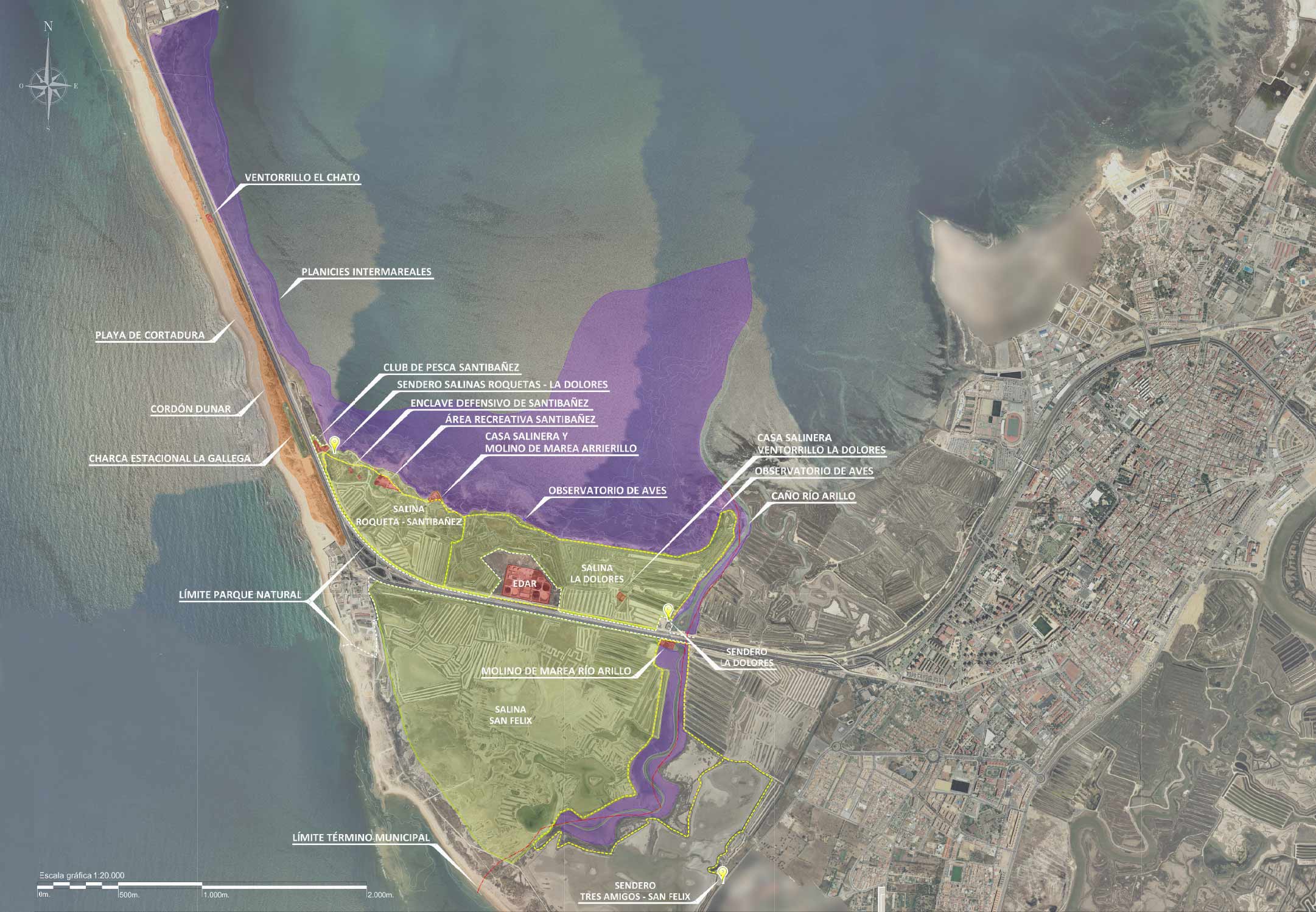
The Nature Park
Ecosystems
Patrimonial and historical elements
Walking Trails
List of birds
Links
The Nature Park
The Nature Park of the municipality of Cadiz
The Bay of Cadiz Nature Park, declared as such on 28th July, 1989 due to the extraordinary ecological value of the ecosystems that make it up and the species it harbours, has a total surface area of 10522 hectares, belonging to the municipal boundaries of Cadiz, San Fernando, Chiclana, Puerto Real and El Puerto de Santa María.
Its location between the neighbouring Doñana National Park and the Strait of Gibraltar, makes the Bay of Cadiz a key part of the migratory system of many birds.
Beaches, salt marshes, salt flats, intertidal flats, pine forests and tidal channels constitute a mosaic of habitats that serve as breeding, wintering and migration areas for populations of more than 200 species of aquatic birds. Their strategic location between the neighbouring Doñana National Park and the Strait of Gibraltar, makes the Bay of Cadiz a key part of the migratory system of many birds.
In addition, the diversity of present ecosystems, allows the existence of different plant formations that constitute the habitat of numerous species of birds, fish, mammals, amphibians, reptiles, molluscs, crustaceans and other invertebrates that make up the diverse and abundant, rich fauna of this protected natural space.
Therefore, the area occupied by the Park constitutes a highly protected area by the following International Protection Agreements as well as by Autonomous Laws of Protection of the Natural Environment:
- Since 2002 it has been included in the List of Wetlands of International Ramsar Importance.
- In 2003 it was included in the Inventory of Protected Natural Spaces of Andalusia as a Special Protection Area for Birds (ZEPA) and included in the European Nature Network 2000
- Since 2006 it has been included in the List of Places of Community Importance (SCI).
- In 2012 it was declared a Special Conservation Zone (ZEC).
How is the Bay of Cadiz formed?
The Bay of Cadiz has been shaping its landscape over millennia due to effects of the sea, the winds and the Guadalete River. During the glacial periods of the Pleistocene, the torrential nature of the watercourses and the decrease in sea level caused deposits of gravels on the Pliocene basement of the Bay, forming the oyster stone. The Guadalete emptied into a wide estuary that ran from El Puerto de Santa María to Sancti Petri, with the two islands of Cadiz (Eritheia and Kotinoussa) and that of San Fernando (Antipolis) in its interior. After the glaciations, the sediments that were deposited are finer (sands, silts and clays) and the sea level rose. Due to its contact with the sea and the river, sandy barriers (The Levante Beach, Camposto-Sancti Petri, ..) were formed. This action was causing the closure of the estuary, thus facilitating the deposit of sediments in the interior of the Bay and originating the marshes. Furthermore, the wind was dragging the sand away from the beaches, forming coastal dunes like those of Cortadura beach, Camposoto or the Levante beach.
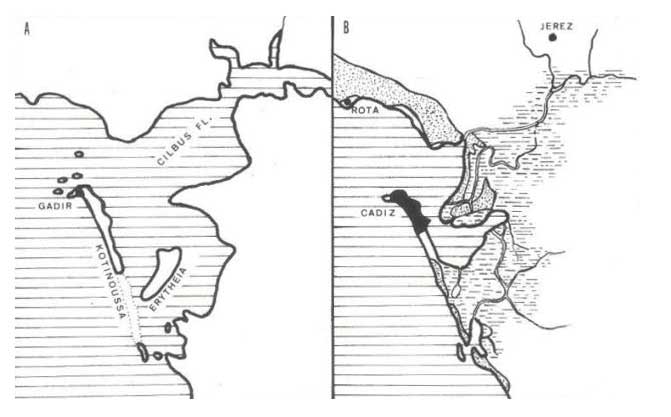
With the settlement of numerous civilisations and towns, the historical use of the bay and its rich resources were not majorly affected. It took advantage of its shellfish and fishing resources, the oyster stone for construction and the transformation of some marshes like salt lakes, which have been known since Phoenician times. However, at the end of the 19th century, human occupation continued to increase and thousands of hectares of marshes were transformed into salt marshes, leaving few as a natural marsh. It was during the 20th century when the bay suffered the greatest changes. Owing to a huge urban boom, the drainage of 5000 hectares of marshes between the Guadalete and San Pedro rivers had to be carried out. There was also the creation of several industrial estates, the conversion of numerous salt mines to fish farms and the construction on the beachfront which led to contamination of water by human and industrial discharges.
This situation led to environmental groups, who had been promoting the protection of the area for years and who were supported by the City Councils of the Bay and the Provincial Council to send a proposal to the Andalusian Parliament in 1989. They wanted the Bay of Cadiz to be included in the Inventory of Natural Protected Areas of Andalusia as a Nature Park, whose Law was being processed, in order to be able to make the conservation of this natural space compatible with the rational use of its resources.
As a particularly interesting fact, it should be noted that the Cadiz Municipal District has approximately half of the protected area as a Nature Park, including three of the most important ecosystems present in the Bay of Cadiz Nature Park: dune beds of beaches, salt flats and plains of intertidal muds, as well as a seasonal freshwater pond.
These spaces of great interest and ecological value of the Municipal District of Cadiz are:
- The ridge of Dunes and Cortadura Beach (including the stretches of El Chato, Torregorda and Santibañez)
- Las Salinas de La Dolores, Roquetas and San Felix.
- The intertidal plains of the inner part of the bay to the left of the Cadiz-San Fernando road, the outside areas of the Salinas Roquetas (Santibañez) and La Dolores, as well as the Caño del Río Arillo, a natural border with the municipality of San Fernando and the Seasonal Pond of La Gallega.
En cuanto a elementos constructivos y arquitectónicos de valor histórico y cultural, en estos espacios se encuentran tres salinas tradicionales abandonadas, la Salina de la Dolores, la Salina La Roqueta o Santibañez y la Salina San Félix; la casa salinera El Ventorrillo de la Dolores; los Molinos de Mareas Río Arillo y Arrierillo o Santibañez o el Enclave Defensivo de Santibañez.
As for constructive and architectural elements of historical and cultural value, in these spaces there are three traditional abandoned salt lakes, the Salina de la Dolores, the Salina La Roqueta or Santibañez and the San Felix Salt Lake; the salt house El Ventorrillo de la Dolores; los Molinos de Mareas Río Arillo y Arrierillo or Santibañez or the Defensive Enclave of Santibañez.
Finally, as features of the Nature Park in the municipal area, there is the Salina de la Dolores Trail, whose route can be extended if you return, passing the Salina Roqueta, which includes an entertainment area with a picnic zone and the Tres Amigos-Río Arillo Trail. Although the trail starts and goes through the Salina de Tres Amigos in the municipal district of San Fernando, it also includes the Molino de Mareas of the River Arillo and returns from the outside by the Caño of the River Arillo of the San Felix salt lake, both belonging to the municipality of Cadiz.
Ecosystems
Ecosystems in the municipality of Cadiz
The municipality of Cadiz has approximately half of its total area protected under the title of a Nature Park and includes three of the most important ecosystems present in the Park: dune beds of beaches, salt flats and intertidal mud flats, as well as a seasonal freshwater pond.
Each ecosystem that makes up the Park has natural vegetation adapted to its conditions and a specific associated fauna that uses available resources. In this way, this space constitutes a true “green lung” for the municipality.
These spaces of great interest and ecological value and that are within the Municipal Term of Cadiz are:
- The Coastal Dune and La Cortadura Beach (including the stretches of El Chato, Torregorda and Santibañez),
- Las Salt Lakes: La Dolores, La Roqueta and San Felix
- The Intertidal Plains of the inner part of the bay to the left of the Cadiz-San Fernando road, the outside areas
of the Salinas Roquetas (Santibañez) and La Dolores, as well as the Caño of the River Arillo, a natural border with the municipality of San Fernando and the Seasonal Pond of La Gallega.
Patrimonial and historical elements
Patrimonial and historical elements in the municipality of Cadiz.
The salt lakes of the Nature Park in the Bay of Cadiz belonging to the municipality, don´t only house important ecological wealth. For a very long time, these spaces have been used by the settlers for the extraction of salt, both for consumption and preservation of food and they came to constitute one of the key industries of the Bay until the mid-twentieth century. Because of the difficulty of the displacements in the marsh, a variety of scattered houses where the salt workers and their crew lived were emerging on the salt flats. Thus, the salt activity, modelling the landscape of the natural marsh, has left some remains of great cultural and ethnological interest such as the salt houses, with their characteristic form of construction, elements that survive what was the “culture of salt” in the area and that constitute a fundamental element of the landscape. One of the most emblematic salt houses in the Bay of Cadiz is El Ventorrillo de La Dolores, located to the left of the Cadiz-San Fernando motorway, in the La Dolores salt lake.
Another important patrimonial element in the landscape of the marsh is the tide mills. Observing that twice a day the sea level rises and later falls, in a rhythmic and periodic movement, humans learned to take advantage of this cyclic oscillation of water as a driving force that moved mills built to grind grain. During the seventeenth and eighteenth centuries, an important reference in the industrial activity of the area was that these mills were built on the same channel of a pipe, which were the technological exponents of this pre-industrial era. Thus, on the right bank of the motorway from Cadiz to San Fernando, shortly before crossing the Arillo River, there is one of the most emblematic mills in the Bay: the Marea of the River Arillo Mill. With its twelve grinding stones, it was considered one of the most important tidal mills in the entire western Atlantic. There are also the remains of another smaller tide mill located in the salt lake of La Roqueta (according to the time and source that is consulted, it is also known as the Arrierillo, La Roqueta, Larraque or La Merced).
Finally, among the remains of a defensive historical heritage that can be found in our area, we can discuss the Santibáñez Defensive Enclave, a group formed by the tidal mill of Santibáñez. The adjacent esplanade was fortified at the beginning of the 19th century, in which they located barracks for troop accommodation and a pier. Other buildings were also erected in the early nineteenth century that are located very close to this nucleus: a guardhouse, a powder store and spare parts. This enclave formed part of the Third Line of the defences established during the siege of the cities of Cadiz and San Fernando (called Isla de León at that time) between February 1810 and August 1812 by the Napoleonic armies. In addition, the artillery participated in the capture of the French Admiral Rosilly’s squadron in June 1808, and in the Constitutionalist uprising against the absolutist government of Ferdinand VII of 1820.
Walking Trails
Walking Trail of La Dolores and Roquetas Salt Lakes
It is a path whose entrance is located right next to the Santibáñez Fishing Club (Club de Pesca Deportiva Santibáñez) and runs through the outside of both salt lakes. It surrounds a publicly owned picnic area of the recreational area of the nature park, passing through the Santibáñez guard houses and the houses used for ammunition. In addition, it runs alongside the ruins of the old Mill of the Arrierillo and of a salt house of Roquetas. From here, the trail continues along the outward turn of the salt lakes of Roquetas and La Dolores, where, to the left, you can find muddy intertidal plains with a multitude of aquatic birds feeding at low tide. Furthermore, it is possible to find bird populations that border the inner part of the Bay which can be seen from two bird observatories already in the salt lake of La Dolores. On the right, you can find the different structures of the salt lake (lucios, vueltas de periquillos, cristalizadores, estero…) and the unique salt house of the Ventorrillo de la Dolores.
The trail can be circulated if we return on the path that goes from San Fernando to Cadiz parallel to the railway. It was built to make up for the expropriation of the natural park.
Walking Trail of Tres Amigos – Río Arillo _ San Félix
Although this trail starts and runs through part of the Salt Lake of Tres Amigos in the municipality of San Fernando, it also includes the Tide Mill of the Arillo River and the outward turn around the Caño del Río Arillo of the San Félix Salt Lake, belonging to the municipality of Cadiz.
List of birds
List of aquatic and marine birds in the Bay of Cadiz Nature Park
Greater Flamingo (Phoenicopterus roseus)
Great cormorant (Phalacrocorax carbo)
Eurasian Spoonbill (Platalea leucorodia) NESTING
Black-winged stilt (Himantopus himantopus) NESTING
Pied avocet (Recurvirostra avosetta) NESTING
Kentish plover (Charadrius alexandrinus) NESTING
Common Ringed Plover or Ringed Plover (Charadrius hiaticula)
Grey plover (Pluvialis squatarola)
Eurasian oystercatcher (Haematopus ostralegus)
Common Sandpiper (Actitis hypoleucos)
Terek Sandpiper (Xenus cinereus)
Ruddy Turnstone (Arenaria interpres)
Sanderling (Calidris alba)
Dunlin (Calidris alpina)
Red knot (Calidris canutus)
Curlew Sandpiper (Calidris ferruginea)
Little stint (Calidris minuta)
Common Moorhen (Gallinula chloropus)
Common Snipe (Gallinago gallinago)
Bar-tailed Godwit (Limosa lapponica)
Black-tailed Godwit (Limosa limosa)
Whimbrel (Numenius phaeopus)
Eurasian Curlew or Common Curlew (Numenius arquata)
Spotted redshank (Tringa erythropus)
Common Greenshank (Tringa nebularia)
Common Redshank or Redshank (Tringa totanus)
Little Tern (Sternula albifrons) NESTING
Caspian Tern (Sternia caspia)
Sandwich tern (Thalasseus sandvicensis)
Grey Heron (Ardea cinerea)
Little Egret (Egretta garzetta)
The Great Egret (Egretta alba)
Cattle Egret (Bubulcus ibis)
White Stork (Ciconia ciconia) NESTING
Black Stork (Ciconia nigra)
Great Crested Grebe (Podiceps cristatus)
Black-necked Grebe (Podiceps nigricollis)
Little Grebe or Dabchick (Tachybaptus ruficollis)
Eurasian Coot (Fulica atra)
Common Moorhen (Gallinula chloropus)
Pintail or Northern Pintail (Anas acuta)
Northern shoveler or Shoveler (Anas clypeata)
Eurasian wigeon (Anas penelope)
Common Scoter (Melanitta nigra)
Mallard (Anas platyrhynchos) NESTING
Shelduck (Tardona tardona)
Yellow-legged Gull (Larus michahellis) NESTING
Lesser Black-backed Gull (Larus fuscus)
Black-headed Gull (Larus ridibundus)
Slender-billed Gull (Larus genei)
Mediterranean Gull (Larus melanocephalus)
Audouin’s Gull ( Larus audouinii)
Osprey, Western Osprey or Sea Hawk (Pandion haliaetus) NESTING
Western Marsh Harrier (Circus aeruginosus)
Short-eared Owl (Asio flammeus)


